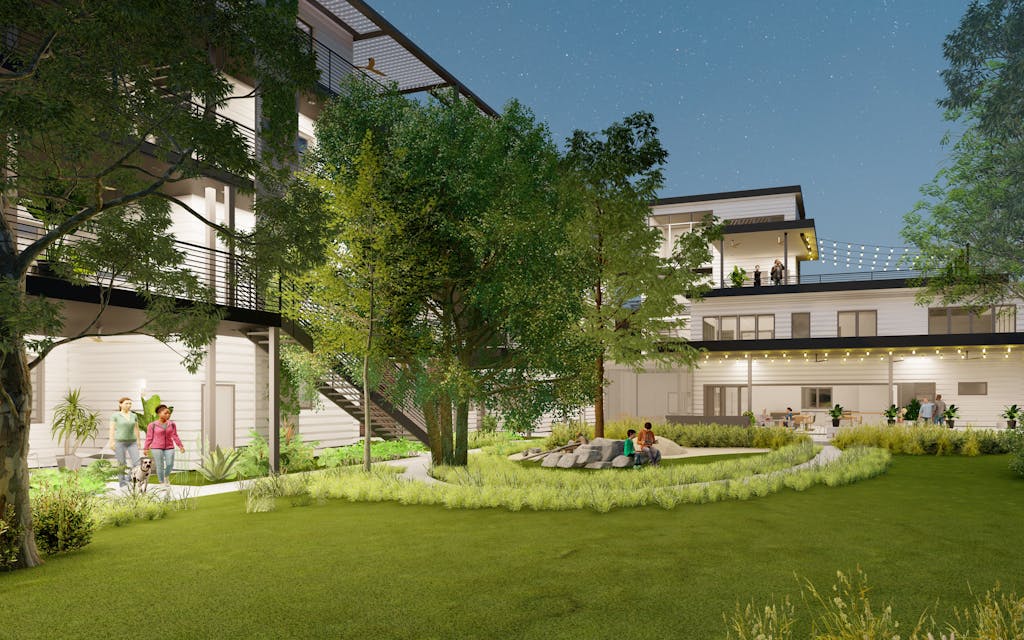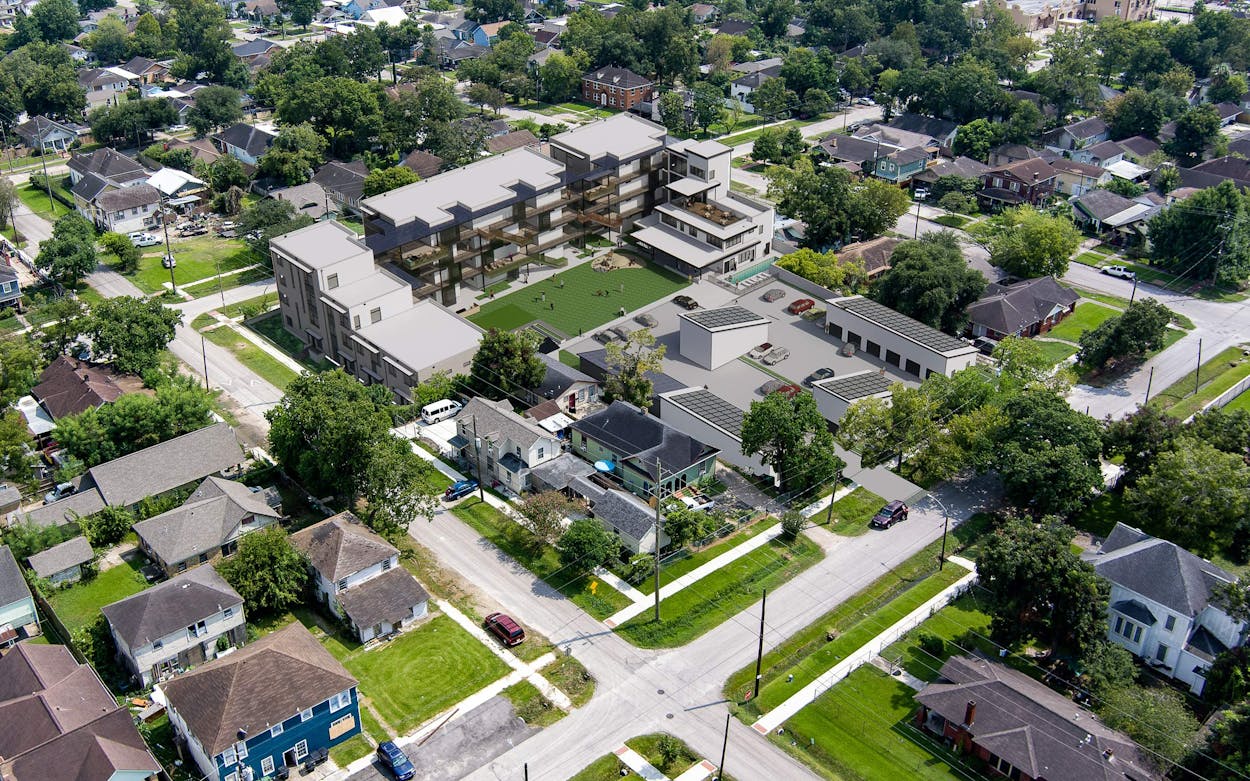“My family thinks I’ve completely lost my marbles,” says Lynn Morstead. Early next year, the retired ExxonMobil IT project manager and her husband will downsize from their 3,300-square-foot home in Houston’s wealthy Braes Heights neighborhood to a much smaller four-bedroom apartment in Texas’s first cohousing development, under construction now in the city’s diverse, working-class Second Ward neighborhood.
What she’s losing in square footage and premier zip code status, Morstead hopes to gain in community, connection, and a more sustainable lifestyle. She wants to create a life in Texas that draws on aspects of what she remembers from growing up in Argentina and Northern England, and later living in Germany and Belgium. She told me a story about a family in Belgium whom she spontaneously invited over for leftovers after church one Sunday. “They stayed all afternoon until supper! I just thought, ‘Oh my gosh, in the States, everybody’s so hyperscheduled—we’ve got stuff to do. We don’t just lounge around, visit, and socialize.’ I forgot this is the way it is.”
Morstead wanted to bring that open-door feeling to Houston, so in 2017, she started gauging interest in the idea of a cohousing development through social media posts, Facebook ads, monthly public meetings, a website, and dozens of one-on-one conversations. The response was overwhelmingly positive. Six years later, CoHousing Houston is nearing completion. Thirty of its 33 condo units have been reserved, and residents are expected to move in sometime this spring.
So what exactly is cohousing? For starters, it’s not a commune. While terms used by some advocates, such as “intentional living” and “community ecovillage,” might conjure the scent of patchouli and visions of worn couches and communal pots of vegan chili, this is typically something more mainstream. Cohousing originated in Denmark in the sixties; it’s been around for a long time in Europe and in the northeastern U.S. but has gained wider attention in recent years. Some of the United States’ roughly 170 established cohousing communities do have a hippie vibe, while others are more straitlaced. All emphasize living with consensus-based decision-making and prioritizing relationships, connection, and support. In cohousing neighborhoods, residents have their own private homes, but they also share some spaces, such as kitchens, gardens, and lawns. Neighbors might lend one another sports gear, exchange childcare, offer rides to the airport, or gather for potlucks and holiday celebrations. Rather than a financial or legal construct, cohousing is a way of life that allows residents to participate in the space’s design and operation—a little bit like an HOA on steroids, with less policing of lawn height and more movie nights.
Previous cohousing attempts in Texas (and some in other parts of the country) haven’t made it across the finish line. “It’s hard to keep it going and keep taking the next steps,” says Morstead. “We just got lucky with the right people and skill sets to stick with it.” The future residents include architects (one of whom, Kathleen English, designed the property), physicians, academics, chemists, engineers, and a psychologist. Not only does starting a cohousing development take a commitment from a group of like-minded individuals, it also requires management skills, money, and a willingness to participate in consensus-based decision-making, which is antithetical to our independently minded, capitalistic social norms in the U.S.
It’s no surprise that a lot of people just don’t like consensus-based decision-making. “They don’t want to spend hours talking about how to put in a perimeter fence,” says Karen Gimnig, a professional facilitator for cohousing communities. She says if communities don’t invest in learning how to do it, those cohousing developments are much less likely to work. “It turns out that really listening to other people and totally engaging in what they are saying so you can totally validate their opinion is hard emotional work. And since nobody’s good at it, it’s even harder at first.” In Houston, Morstead and her cofounders have held hours of meetings over coffee with prospective or merely curious cohousers, talking about the concept and the actual development project.

Depending on your perspective, Houston is either a crazy place to try this experiment, or a perfect one. The nation’s second-fastest-growing and fourth-most-populous metro area is notoriously sprawling and car-centric, a concrete jungle that lacks zoning and is rarely cited as an example of progressive urban planning. And, of course, it’s in Texas, where wide-open spaces, big houses, and independence are deeply ingrained norms. On the other hand, Houstonians are an open-minded, culturally diverse and creative bunch. “It’s a different dynamic down here,” says Dustin Miles, managing partner of Momentum Multifamily, a private equity development firm focused on Houston real estate. “I feel like they [Houstonians] are okay with trying things that are out of the box.” The ambitious Memorial Park renovation plan is a great example of just that.
Part of the “pathway to ownership” at CoHousing Houston means putting your time and money into the process. The average cost of a unit is $550,000, significantly higher than the city’s median home price of $332,000 (though some units are available in the $300,000s, with larger ones going up to $800,000). For $150, potential residents get open access to all the financials, building designs, internal meetings, and gain an important education about what consensus decision-making is all about. From there, future residents can apply for membership, as one might in a fancy Manhattan co-op. If their application is approved, they put down 20 percent toward the total cost of their unit. When construction is finished next year, each resident will own their unit and part of the entire development.
Unlike traditional single-family ownership, families aren’t just buying square footage. They’re buying community, connection, collaboration, and support. There will be a 4,200-square-foot “common house” where residents cook meals and hang out, plus an edible garden and an interior courtyard for games like badminton. Sustainability is built into the community, too, with a geothermal heating and cooling system and a composting setup. Everyone owns and operates these spaces jointly.
“The difference in cohousing is that you’ve got a community of people who are dedicated to looking out for each other,” says Kelli Soika, a future CoHousing Houston resident. When she, her husband, and their three teenage daughters move into CoHousing Houston next year, it’ll be the family’s third cohousing experience. They enjoyed the lifestyle for six years—one year in Fort Collins, Colorado, and then five in Lafayette City, Colorado—but had to relocate back to Texas for work. Soika says cohousing makes parenting less stressful, since there are extra adults around to help watch the kids. That gives a busy mom or dad the freedom to do something as simple (but sometimes difficult) as going to the grocery store.
For single parents, cohousing might be a dream come true. Susan Daniels will find out soon. The single, working mother to a thirteen-year-old son purchased a two-bedroom unit and has already started spending time with her “mini cohousing group.” Daniels hopes that cohousing will “make having a social life effortless.” She says that right now, planning dinner, drinks, or even a walk with a friend requires so much back-and-forth texting and schedule-coordinating that it often doesn’t happen. But, more importantly, she’s hoping this environment and lifestyle provide a safety net for herself and her child, while giving her space with other adults to share ideas and just connect socially, now that she’s not partnered.
Daniels’ parents are deceased, so she hopes that the multigenerational aspect of cohousing will provide her son, Griffin, with grandparent-like figures who might have the time to do things with him, like help him earn badges for Boy Scouts. “It’s really nice to have that extra sense of resilience that comes from community, and being able to give back as well,” says Daniels.
As a single mom myself, I can relate. When I bought my century-old home in an urban area of Fort Worth five years ago, I thought more about square footage and commute times than about community. Don’t get me wrong: my neighbors are kind and thoughtful. We watch out for each other’s package deliveries and make small talk in the driveway. But I don’t know them, not really. The idea of block parties, progressive dinners, or wine nights on the patio with kids playing in the sprinklers—that sounds pretty great.
A growing body of research suggests that getting to know your neighbors, and building strong social connections in general, really matters. According to the Centers for Disease Control and Prevention, one in three U.S. adults over age 45 feels lonely. Social isolation can increase the risk of heart disease, depression, and dementia. U.S. surgeon general Vivek Murthy declared loneliness a national epidemic earlier this year.
“It’s kind of eye-opening when you look at the numbers,” says Dr. Debra Atkisson, a psychiatrist in Denton and former Texas Christian University medical school professor. “And it’s a real risk to our physical and mental health.” She says there’s an important difference between loneliness and social isolation, which can often happen with older adults. “You can actually have social connections and friends and still feel lonely, because loneliness is when you don’t feel like you have a meaningful connection, or you don’t feel anybody really understands who you are.” With its emphasis on spending substantial time with your neighbors and trading favors, cohousing aims to foster those kinds of meaningful connections.
There’s also an economic cost to loneliness—a big one. The CDC reports that loneliness costs the economy about $406 billion a year because of the way it decreases productivity and workplace fulfillment. “If we want to be a responsible citizen in our community, I think we’ll take a look at ways to increase our own social connectedness . . . because by increasing social connectedness, we’re not only helping ourselves, we’re helping other people individually,” says Atkisson.
Cohousers may be more connected, but they take on certain inherent risks and challenges, too: “Fear, anxiety, and trust,” Atkisson says, pointing out that cohousing residents might be worried about getting used or taken advantage of in some way. Just like any intimate relationship where you’re sharing space with another person, it takes clear boundaries, contracts, and expectations to make a cohousing situation really work.
The queen architect and voice of cohousing in the U.S. is Grace Kim, who gave a viral TED Talk on the subject in 2017. She says studies on life outcomes really come down to social connectedness. “If you live in a connected way, and have that connection in your life, you’ll have greater chances of living longer.”
Americans often have a mentality of needing to do everything alone, Kim points out. We struggle to ask for help, and we fear being a burden to those around us, she says. “I think people aren’t aware of the importance of being connected to other people and lose sight of how supportive interdependence is,” says Kim. “I don’t think it means you give up your freedom; it just means that you have a greater support network for anything in your life.”
Of course, there are ways to incorporate aspects of these lessons into your life without moving to a cohousing community. These days, as I’m looking for a new house for my little family in Fort Worth, I care less about square footage, new fixtures in the bathroom, or a big yard, and much more about the neighborhood. Are there Halloween parties? Progressive dinners? Mothers I can connect with to share my struggles and triumphs? If I want to increase my odds of living long enough to enjoy my grandchildren, I need to create a community of support that can withstand the storms of life—whether that’s a Houston hurricane, a pandemic, or just needing a friend in the room at the end of a really bad day.
- More About:
- Style & Design
- Architecture
- Houston






